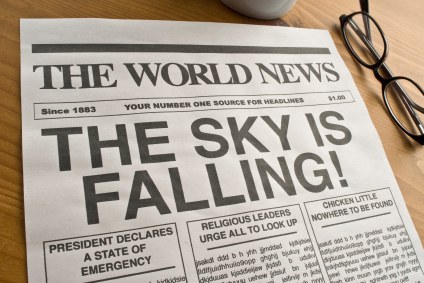Chicken Licken, black swans, and social media
 My last few blogs have explored how social media can open up new avenues of thinking, prompt business transformation, and provide big data. These are all opportunities for organisations.
My last few blogs have explored how social media can open up new avenues of thinking, prompt business transformation, and provide big data. These are all opportunities for organisations.
But social media can bring risk, too. This is well recognised – two-thirds of respondents to our senior management survey thought social media presented business risks. These risks cover a wide range, including reputation, security, privacy, and employment-related issues. And, like our anxious feathered friend, sometimes you think the sky is going to fall at the first RT.
What is required is risk management, with the emphasis definitely on managing. But it's hard to engage people with talk of risk management. It's usually a topic guaranteed to clear the kitchen at parties – much like telling people you're an auditor.
Some organisations revert to risk avoidance – the search for zero risk – and that's a completely different thing. If you want zero risk, you'd best stay at home, although even that can be risky.
Some organisations revert to ostrich impressions and bury their heads in the sand and/or retrospectively explain it away – "there was no way we could have seen that coming, it's a black swan". But the black swan explanation is sometimes misused as a convenient excuse. So, in the case of our doomed bird, one acorn on your noggin doesn't make it a black swan event – especially when you live in a forest and it's autumn!
Opportunity and risk. Smart organisations think of these as two sides of the same coin and treat them as such, like Kipling's triumph and disaster. Risk management should be a dynamic process. You should be managing risks to safely provide opportunities, and if things do go wrong you are then prepared to act quickly to remedy them. Without taking risks, there will be few opportunities to realise.
Some commentators say that organisations that ignore, restrict, or prohibit social media use may be reducing only some of the risk. The idea is that you can't stop social media, so organisations should stop looking to avoid the risk and start managing it.
Social media can touch many aspects of an organisation's business, so the approach to risk and governance must do so, too. It should be multi-disciplinary, transparent, and with everyone clear about their roles and responsibilities. It needn't be complicated, but it must be well thought out.
Some of our case studies, such as that of MetService, and the Police, show that managing social media risk needn't be subject to lengthy or cumbersome process. Some careful thought and sound management practice should be enough.
The Department of Internal Affairs' high-level guidance provides a useful starting point for organisations that want to get involved in social media, and provides a section on common risks and suggested mitigations.
So don't be like our feathered friend; be a wise owl, manage your risks, avoid the black swan, and enjoy your chicken dinner – instead of ending up on the menu.
